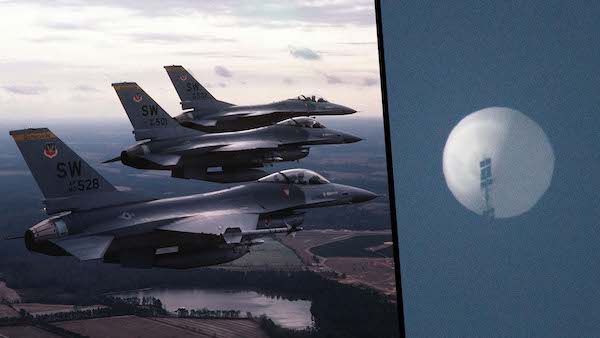A Chinese balloon that the U.S. military shot down had likely been pushed off course by unexpected weather conditions, according to multiple officials in Washington.
This is according to numerous reports in major U.S. media outlets, including the Washington Post and CNN.
In response to hysteria surrounding the Chinese rubber object, the U.S. Air Force subsequently spent roughly $2 million to destroy what appears to have been a hobby group’s $12 balloon.
On February 1, a large Chinese balloon was first seen over the U.S. state Montana.
On February 4, U.S. military fighter jets shot down the rubber object, off the coast of South Carolina.
Washington accused Beijing of using the balloon to spy on U.S. territory.
China adamantly denied that the rubber object was a surveillance device, instead maintaining that it was used for weather research.
There are legitimate reasons to take Beijing at its word. The Washington Post had acknowledged on February 3,
Experts in national security and aerospace said the craft appears to share characteristics with high-altitude balloons used by developed countries around the world for weather forecasting, telecommunications and scientific research.
The Pentagon itself said that “the payload wouldn’t offer much in the way of surveillance that China couldn’t collect through spy satellites” and that “the balloon posed no serious physical or intelligence threat”.
— Arnaud Bertrand (@RnaudBertrand) February 4, 2023
The newspaper quoted an anonymous U.S. “senior defense official” who “said the payload wouldn’t offer much in the way of surveillance that China couldn’t collect through spy satellites”, stating,
I wouldn’t characterize it as revolutionary.
Even the bellicose right-wing think tank the Center for Strategic and International Studies (CSIS)—which is funded by the U.S. government and weapons industry and is notorious for its anti-China bias—called for caution early on, conceding in a February 3 article:
China has not used balloons for spying before, and using a balloon would be a step back. The most likely explanation is that this is an errant weather balloon that went astray—lost weather balloons are the basis of many ‘UFO sightings’.
The neoconservative, US government-funded think tank CSIS is very anti-China, but even it admits:
"China has not used balloons for spying before… The most likely explanation is that this is an errant weather balloon that went astray"https://t.co/WN2Wzil3Zs pic.twitter.com/dG99WtDM9y
— Ben Norton (@BenjaminNorton) February 6, 2023
It was clear from the beginning that the Chinese balloon was part of a manufactured crisis, and its significance, like the rubber object itself, was being blown out of control.
But the media’s hot air had the effect of ratcheting up tensions with China, creating fear among the U.S. public, and leading Secretary of State Antony Blinken to cancel a diplomatic trip to Beijing.
Hawkish U.S. politicians from both the Republican and Democratic Parties, along with neoconservative think tanks, capitalized on the bubble to portray China as a dangerous threat.
Slate reported that Republican Congressman James Comer, who chairs the U.S. House Oversight Committee, warned that the balloon could have “bio-weapons” made in Wuhan, while former House Speaker Newt Gingrich insisted it “could be trial runs for low-visibility deliver[y] of devastating EMP weapons”.
CNBC declared that the balloon “threatens NATO members”, citing the Western military alliance’s bellicose Secretary General Jens Stoltenberg, who denounced the rubber object as a sign of a dangerous “pattern of Chinese behavior”, insisting,
We need to be aware of the constant risk of Chinese intelligence and step up what we do to protect ourselves.
Spy balloon confirms 'pattern of Chinese behavior' that threatens NATO members, Stoltenberg says https://t.co/zaih1xmjGp
— CNBC (@CNBC) February 8, 2023
U.S. Air Force spent $2 million to shoot down hobbyists’ $12 balloon
From February 10 to 12, Air Force fighter jets shot down three objects. At first, U.S. government officials and Western media outlets implied that Washington had targeted more Chinese surveillance devices, but they actually appeared to have been civilian balloons.
The website Aviation Week reported that an amateur balloon belonging to a hobbyist group called the Northern Illinois Bottlecap Balloon Brigade went missing in the same place at the same time as one of these Air Force bombings.
 Aviation Week noted:
Aviation Week noted:
The descriptions of all three unidentified objects shot down Feb. 10-12 match the shapes, altitudes and payloads of the small pico balloons, which can usually be purchased for $12-180 each, depending on the type.
The founder of a company that makes pico balloons for hobbyists told Aviation Week,
I tried contacting our military and the FBI—and just got the runaround—to try to enlighten them on what a lot of these things probably are. And they’re going to look not too intelligent to be shooting them down.
British newspaper The Guardian followed up on this report, in its own article amusingly titled “Object downed by U.S. missile may have been amateur hobbyists’ $12 balloon“.
Researcher Stephen Semler estimated that the Pentagon spent around $2 million in this operation to shoot down the hobbyists’ balloon over Lake Huron.
The Air Force used two AIM-9 Sidewinder missiles in the attack, which cost more than $440,000 each and are manufactured by the arms corporation Raytheon.
How much did it cost to shoot down what was most likely a balloon over Lake Huron? About $2 million, based on my analysis of procurement and operational data: https://t.co/a4f4jrl0eg pic.twitter.com/zguxExdnuz
— Stephen Semler (@stephensemler) February 17, 2023
Immediately after the attacks, the Democratic majority leader of the U.S. Senate, Chuck Schumer, had insisted without evidence that the three objects were spy balloons, declaring,
The Chinese were humiliated—I think the Chinese were caught lying… It’s a real setback for them.
But the U.S. National Security Council spokesman, John Kirby, revealed on February 14 that the three objects destroyed by the U.S. military were likely balloons “tied to some commercial or benign purpose”.
“We haven’t seen any indication or anything that points specifically to the idea that these three objects were part of [China’s] spying program, or that they were definitively involved in external intelligence collection efforts”, Kirby added.
President Joe Biden himself admitted on February 16 that the three objects the military blew up were “most likely balloons tied to private companies, recreation or research institutions studying weather or conducting other scientific research”.
President Biden said Thursday that three unidentified flying objects shot down over North American airspace were "most likely" balloons tied to private companies or research institutions, not part of China's surveillance spy balloon operation. https://t.co/mGO8mBTHuu
— USA TODAY (@USATODAY) February 17, 2023
U.S. intelligence officials acknowledge the Chinese balloon may have been blown off course by weather
Ten days after the Air Force shot down the Chinese balloon, U.S. officials conceded that the rubber object had probably been blown off course by weather.
The Washington Post acknowledged in a February 14 report that the Chinese balloon “may have been diverted on an errant path caused by atypical weather conditions”.
The newspaper reported that the balloon “took an unexpected northern turn, according to several U.S. officials, who said that analysts are now examining the possibility that China didn’t intend to penetrate the American heartland with their airborne surveillance device”.
U.S. “intelligence analysts are unsure whether the apparent deviation was intentional or accidental”, the Post wrote.
“This new account suggests that the ensuing international crisis that has ratcheted up tensions between Washington and Beijing may have been at least partly the result of a mistake”, the newspaper said.
Exclusive: The U.S. tracked the Chinese spy balloon a week before shooting it down off the coast of South Carolina. The Chinese surveillance device may have been diverted on an errant path caused by unusual weather conditions. https://t.co/ESXLKthHhg
— The Washington Post (@washingtonpost) February 14, 2023
CNN also cited numerous anonymous sources and reported, “US intelligence officials are assessing the possibility that the suspected Chinese spy balloon was not deliberately maneuvered into the continental U.S. by the Chinese government and are examining whether it was diverted off course by strong winds“.
The major U.S. media outlet stated that the balloon took “a path that U.S. officials are not sure was purposeful, and may have been determined more by strong winds than deliberate, external maneuvering by Beijing”.
“Weather modeling done by CNN suggests it is plausible that the wind currents at the time diverted the balloon northward toward Alaska”, the network wrote.
CNN added,
U.S. officials have acknowledged that the balloon’s maneuverability was limited.
US officials are looking at the possibility that the spy balloon's path was accidental, determined more by strong winds than a course set by China. https://t.co/Z6iPlTl8dK
— CNN International (@cnni) February 16, 2023
In a speech at the Munich Security Conference on February 18, top Chinese diplomat Wang Yi said Washington’s response to the balloon was “absurd and hysterical“.
He added,
It does not show the U.S. is strong; on the contrary it shows it is weak.

